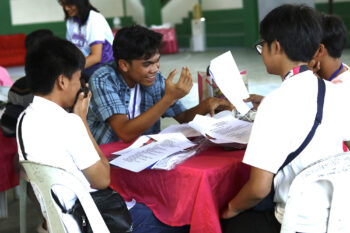TALAKAG, Bukidnon (MindaNews / 06 March) – Good, old-fashioned information, education and communication strategies using the language of the Higaonons and featuring Higanonon endorsers have effectively addressed the problem of vaccine hesitancy here and have ensured that these Lumads (Indigenous Peoples) get vaccinated against COVID-19.
At the basketball court in Barangay Tikalaan here last week, twelve-year-old Nicole held a small bag of potato fritters as she and other Higaonon teenagers waited for their turn to be vaccinated.
As light rain outside the roofed court fell, the Higaonon teenagers and a few elders gathered inside the venue surrounded by posters and tarpaulins promoting vaccination, all in Higaonon language.
“I am not afraid,” Nicole declared.
Her older sister, Gloria, said Nicole was the last in their family of six to get the jab.
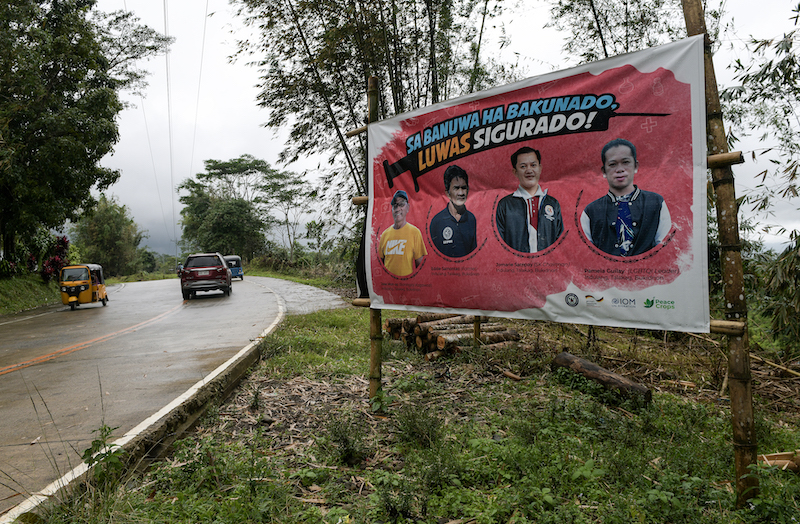 A huge tarpaulin urging fellow Higaonons to be vaccinated against COVID-19 is displayed in a strategic area in Barangay Tikalaan, Talakag town, Bukidnon. MindaNews photo by FROILAN GALLARDO
A huge tarpaulin urging fellow Higaonons to be vaccinated against COVID-19 is displayed in a strategic area in Barangay Tikalaan, Talakag town, Bukidnon. MindaNews photo by FROILAN GALLARDO
Vaccine hesitancy among the Higaonons is no longer a problem here, thanks to good, old-fashioned information, education and communication strategies. There are no posters or tarpaulins in English or Filipino here. Just Higaonon. The posters and streamers also do not feature celebrity endorsers but their own leaders.
The non-government organization Peace Crops is providing all the tarpaulins, posters and other information materials in the four predominantly Higaonon barangays in Talakag: Tikalaan, Indulang, Lantud and San Rafael.
Peace Crops also hands out printed “komiks” containing information on the need for vaccines, the dialogues written also in Higaonon.
Gloria said their family was hesitant at first about the COVID-19 vaccines but got persuaded when they saw their Higaonon leaders inoculated.
“We saw posters of our leaders telling us that vaccination is good for us. We heard they did not get sick. We were convinced,” she said.
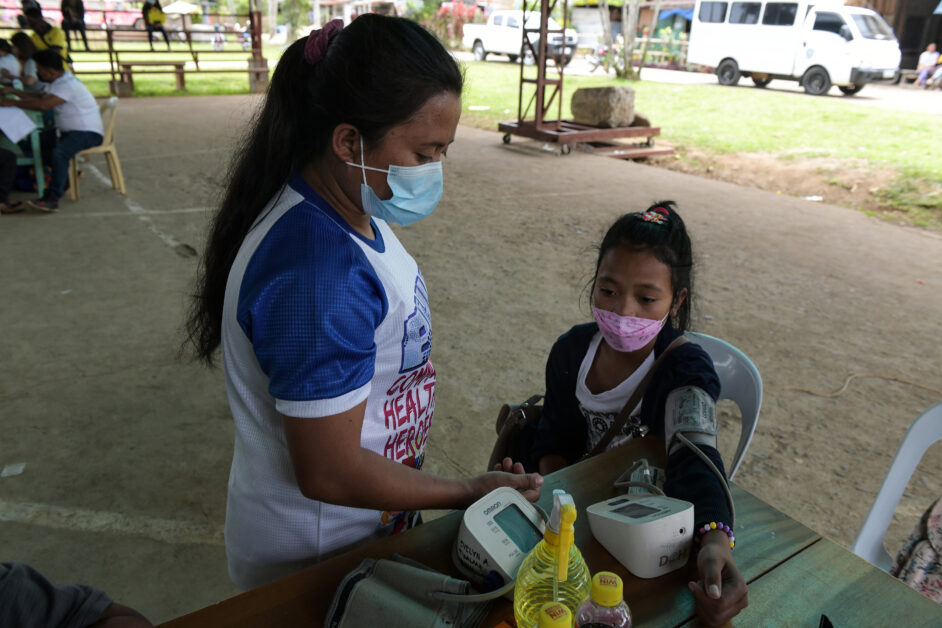 A medical frontliner checks the blood pressure of a Higaonon teenager in Barangay Tikalaan, Talakag, Bukidnon before administering the vaccine to protect her from COVID-19. MindaNews photo by FROILAN GALLARDO
A medical frontliner checks the blood pressure of a Higaonon teenager in Barangay Tikalaan, Talakag, Bukidnon before administering the vaccine to protect her from COVID-19. MindaNews photo by FROILAN GALLARDO
“Magpabakuna para luwas sa alan ha miyembro hu pamilya (Get vaccinated so that your family is safe),” reads a 6×10 feet tarpaulin on the roadside.
Nurse Lourdes Tinoy of the Talakag Health Office said vaccination hesitancy was high among Lumad families when the campaign started a year ago.
“There was a perception that vaccines were against their culture,” she said.
Tinoy said with the aid of the information materials, the vaccination program of the Talakag municipal government succeeded.
She said they have already vaccinated 70 percent of their 72,027 residents as of January 2022.
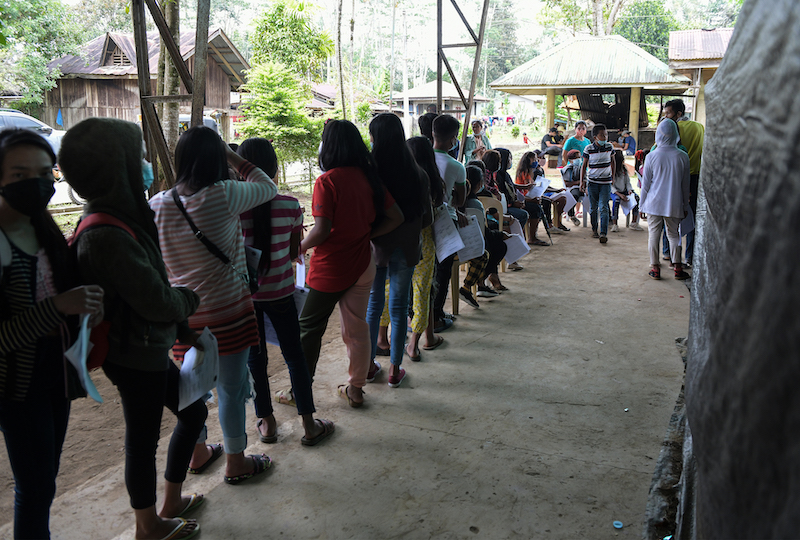 Higaonon teenagers line up at a mobile vaccination center in barangay Tikalaan, Talakag Bukidnon for their COVID-19 jab. MindaNews photo by FROILAN GALLARDO
Higaonon teenagers line up at a mobile vaccination center in barangay Tikalaan, Talakag Bukidnon for their COVID-19 jab. MindaNews photo by FROILAN GALLARDO
“It was a slow progress but when the information campaign went full gear, more residents turned up at the vaccination center,” she said.
Kagawad Edgar Gamat of Barangay Tikalaan, said he was also apprehensive because of what he read and watch in different social media platforms.
Gamat, a Higaonon, said nobody from the ten-member Tikalaan Barangay Council dared to volunteer for vaccination.
“We thought we would die if we would be vaccinated,” he said.
Gamat said their perception changed after seeing that nothing untoward happened to their barangay health workers (BHWs) who were vaccinated.
He said the order of the Department of Interior and Local government on mandatory vaccination for all barangay officials nationwide also added to the decision to go for inoculation.
“I kept looking at the long needle and just closed my eyes,” he said.
Gamat and the rest of the Tikalaan barangay council are now fully vaccinated. They are just waiting for their booster shots.
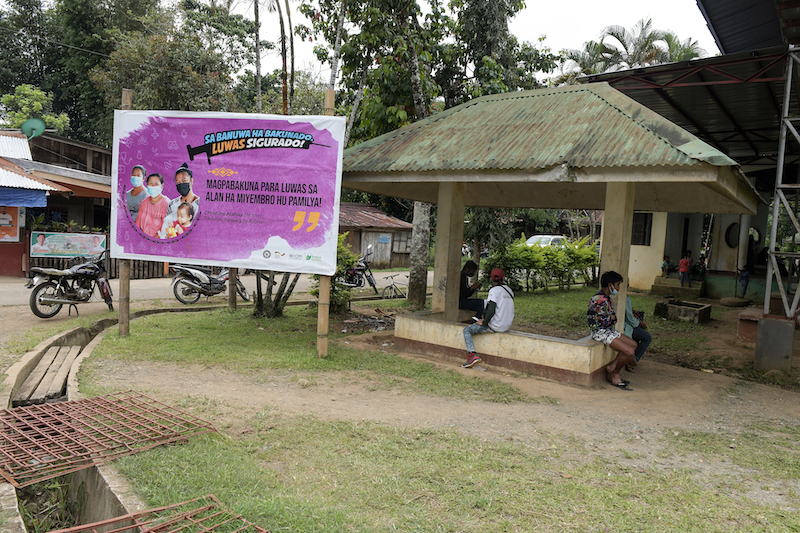 A huge tarpaulin urging fellow Higaonons to be vaccinated against COVID-19 is displayed in a strategic area in Barangay Tikalaan, Talakag town, Bukidnon. MindaNews photo by FROILAN GALLARDO
A huge tarpaulin urging fellow Higaonons to be vaccinated against COVID-19 is displayed in a strategic area in Barangay Tikalaan, Talakag town, Bukidnon. MindaNews photo by FROILAN GALLARDO
Peace Crops president Robert de la Serna said the vaccine information materials they designed were effective because they used the Higaonon language and Higaonon leaders as their endorsers.
“We found Lumad residents were able to relate quickly if they see their leaders promote vaccination. It changed their negative perception to vaccines quickly,” he said.
Peace Crops was given funding by an international aid agency to design a communications strategy to counter vaccine hesitancy among the Lumads in four barangays here.
“We started by conducting Focus group discussions among the Lumad leaders and their barangay officials,” he said.
De la Serna learned during the meetings, that vaccine hesitancy among the Lumads was not rooted in their cultural beliefs but in the disinformation they received from radio and television and for Lumads who have internet access, from social media platforms.
“We decided we had to counter the disinformation and fake news with a good information, education and communication strategy,” he said.
De la Serna said they also decided to use influential Higaonon leaders to deliver the message to the community that vaccines are safe.
“One good example are the barangay health workers and Higaonon leaders,” he said.
At the covered court in front of the Tikalaan barangay court, a stream of children aged 12 and above lined up for vaccination.
Eugenio Borreta, a member of the Talakag Inter-Agency Covid Task Force and head of the vaccination team in Tikalaan said they are glad that vaccine hesitancy among the Higaonon residents has been reduced and credits this to the effective information campaign.
“The families are bringing their children to us unlike before when they were very hesitant,” Borreta said.
He assured residents they have enough vaccine to accommodate all the children and those coming in for their second dose or booster shot.
Borreta said they get their supply of vaccines from the Bukidnon provincial health office, which in turn gets it from the Department of Health region 10 office in Cagayan de Oro. (Froilan Gallardo / MindaNews)
(This story was produced with support from Oxfam Philippines)
